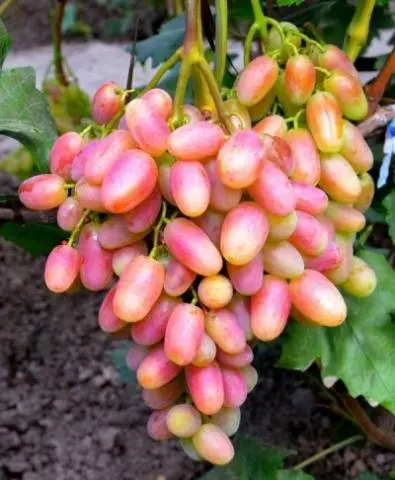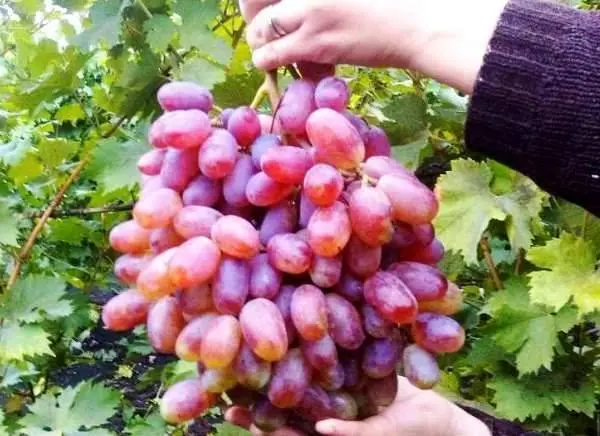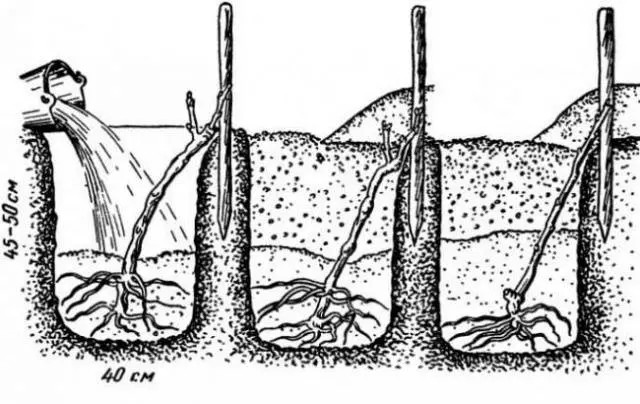Contents
Not every grape variety is able to survive the harsh winter and at the same time please the owner with a generous harvest with delicious fruits. The difficulty of growing crops in the northern regions lies in the limitation of the number of warm months. In such conditions, clusters of only very early varieties will have time to ripen. One of them is the Julian grape, characterized by unpretentiousness and high yield.
Main characteristics

Julian is a hybrid resulting from crossing two well-known varieties: “Kesha” and “Rizamat”. The result of the selection was approved by many growers. It would be more correct to start describing the Julian grape variety from the vine. Bushes are characterized by intensive growth. However, the vine has time to quickly mature along its entire length, which is important for the northern regions. After all, the summer here is quite short. The root system is highly branched and similarly characterized by rapid growth. The cuttings of the Julian hybrid are distinguished by good survival, take root quickly, and are also suitable for rootstocks for many grape varieties.
According to the photo, the description of the Julian grape variety can be described as a culture that brings large pink clusters. Delicious berries are eaten fresh or used to decorate cooked dishes. Variety Julian is considered table. Ultra-early ripening of clusters occurs in early August. That is, the berries need up to 100 days to be edible.

If you take a closer look at the photo of Julian grapes, then any specialist will determine the similarity of the shape of the clusters with the Rizamat variety. And this is so, because he is one of the parents. Julian’s berries do not fit tightly to each other. From this, the clusters are a little loose. The shape of the berries is even, elongated in the form of a finger. The length of the grape is about 4 cm, and the thickness reaches 2,8 cm. The weight of one berry is 15 g, but there are also larger specimens of 20 g each. Grape clusters always grow large. With normal care, their weight varies from 0,7 to 1 kg. If you follow all the top dressing and care rules, you can get clusters weighing up to 2 kg.
For Julian grapes, gardeners’ reviews often begin with a description of the color of the berries. This is due to their unusual beauty. After aging, the skin acquires a pink color, but at first yellowness predominates, beautifully glowing in the sun. The skin of a fully ripened berry may be partially covered with a lilac tint. The flesh is slightly crispy. Taste qualities resemble a mixture of nutmeg with strawberries. The seeds are quite soft and there are very few of them inside the grape. The skin is thick but thin. It is practically not felt when eating berries.
Ripe bunches are stored for a long time without losing their presentation. Grapes can be transported, which allows it to be used for commercial purposes. The dense skin does not crack on the berries during their storage.
Continuing to consider the description of the Julian grape variety, it is worth noting the frost resistance of the culture. The vine can withstand temperatures down to -23оC. Another important factor is Julian’s resistance to drought. Such characteristics make it possible to grow a variety in many regions, even with an unfavorable climate. To protect against frost, the vine is slightly covered for the winter. In the southern regions, the temperature does not drop enough to harm the vine, so here the grapes remain attached to the trellis. It makes no sense to cover the vine.
Julian, like most hybrids, is weakly affected by fungal diseases. In a favorable summer, grapes can not be sprayed with chemicals, and you can get a good harvest. However, in the event of an epidemic and a rainy summer, it is advisable not to take risks. It is better to carry out prevention by spraying with preparations to protect berries and foliage.
Julian grapes are better described by the video, which we suggest that you familiarize yourself with:
As practice shows, after planting grapes with cuttings, the first harvest, with proper care, can be obtained in the fourth year.
Pests and bacteria

Considering photos, reviews, descriptions of Julian grapes, it is worth touching on another important problem – these are crop pests. Some of them are wasps and birds. If the berries are not cracked from oversaturation of moisture, then insects will not overpower the hard skin. But birds love to eat sweet grapes. When the clusters begin to ripen, it is advisable to close Julian’s plantings with a barrier net.
Bacteria are harder to deal with. Even an experienced grower is not always able to accurately determine what the crop is affected by. Despite the fact that this hybrid has good characteristics, unpleasant situations occur during the epidemic of fungal diseases. Julian is not afraid of bacteria that cause gray rot, oidium, mildew, and also a tick. However, in hot, humid summers, when the temperature outside is +25оFrom and above, the likelihood of fungal infection increases.
A serious danger to the Julian variety is:
- Manifested by Alternaria, many growers define it as oidium. This is a very dangerous disease. The bacterium infects everything: foliage, young shoots, inflorescences and all clusters. Berries become 100% unfit for human consumption. At the first manifestations of the disease, Julian’s bushes should be sprayed with a 2% solution of Bordeaux mixture. The bacterium can even infect mature bunches lying in the basement. Here you just need to follow the rules for storing grapes.
- In warm regions, Julian grapes are exposed to another dangerous bacterium that causes spotted anthracnose. The disease is manifested by the darkening of the foliage. Over time, they completely die off. The method of struggle is the same – Bordeaux liquid. However, Julian grape bushes should be sprayed only after the first shoots have grown at least 10 cm long.
- Downy mildew, as well as mildew for the Julian hybrid, is practically not terrible. However, it’s not worth the risk. In the hot summer, grape bushes should be treated with drugs for prevention. If suddenly the disease manifests itself, then the vineyard is sprayed with fungicides or a solution of copper sulfate.
Prevention of fungal diseases for the Julian hybrid is mandatory in any case. It is better to prevent the disease than to try to cure it later. Moreover, in some advanced cases, even potent drugs will not help save the crop.
In the video, the Julian grape variety is presented for better familiarization:
Planting grape seedlings
You can breed the Julian variety on your site with seedlings. Before disembarking, a visual inspection should be carried out. High-quality planting material is distinguished by a developed root system. This allows the grape seedling to quickly adapt to open ground and take root. Planting Julian grapes is best done in the spring. This guarantees a greater percentage of seedling survival. Julian’s landing rules are the same as for all hybrids:
- A place for planting grapes has been prepared since autumn. It doesn’t matter if it’s a pit or a trench, the main thing is to create a nutrient substrate for the root system. It consists of a mixture of humus with fertile soil and the addition of fertilizers. It is important not to forget to equip the grape seat with a drainage layer.
- In the spring, the roots of selected seedlings up to 15 cm are cut off. After this procedure, they are immersed in a stimulating solution for rapid growth. If there are weak or damaged shoots on the grape seedling, they are cut with a sharp pruner.
- A support peg is driven into the center of the hole. It can be a steel rod or a wooden stick. The seedling is lowered into the hole, tied to a peg, after which it is covered with a substrate and watered abundantly.

- Under each seedling you need to pour at least 1,5 buckets of water. Over time, the soil in the hole will sag. It will need to be sprinkled.
In order for the roots of the grapes to receive oxygen, mulching with sawdust is performed around the seedling. You can add a little humus.
Care during cultivation

Hybrid Julian took all the best qualities from his parents. Due to resistance to diseases, it is usually enough to do prophylactic treatment with drugs twice a season. The rest of the activities are aimed at watering, fertilizing and forming a bush. Grape care involves the following actions:
- Before the start of the growing season and preparing the grapes for wintering, abundant watering of the bushes is carried out. At this time, moisture is abundantly absorbed by the roots to charge the vine for the entire period.
- In dry summers, the grapes are watered, guided by the state of the soil.
- If there is no mulch layer in the hole, there is a need for organic matter. To replenish nutrients, it is recommended to make organic compounds once a year.
- You can increase the quality and quantity of the grape harvest by reducing the overload of the bushes. To do this, remove the extra clusters and inflorescences. Usually, 40 to 45 eyes are left for each grape bush. Vine pruning is performed on 8 or 10 eyes.
Hybrid Julian is characterized by one feature. In the soil oversaturated with moisture, survival and development of up to 95% of seedlings is observed. And the best quality of the crop is inherent in the grafted culture.
Reviews
The reviews presented about the cultivation of Julian grapes in Siberia say that this hybrid is able to take root even in such harsh conditions.










